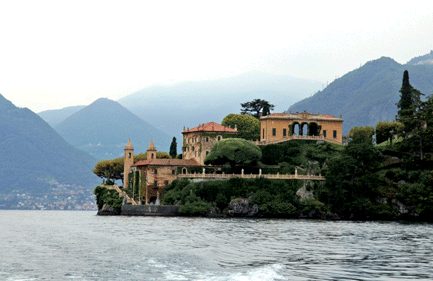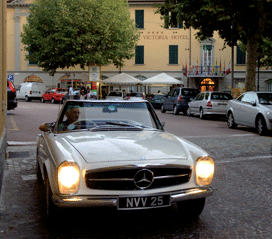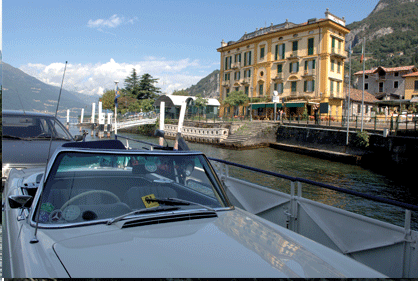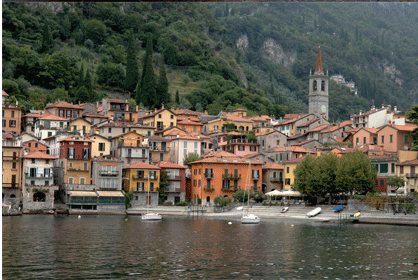Classic Car Touring
Off to Lake Como in a ’69 Merc
A drive to scenic northern Italy in an open Benz lends its own charm
Although many people nowadays are advocates of GPS systems to guide them through unknown territory, as chief navigator of the trip, I refused to have one. I enjoy the process of planning journeys, map reading, getting lost, asking strangers the way, and generally wondering where we might spend our next night.
Lake Como is a glacial lake in northern Italy, surrounded mainly by high mountains. Being 400 meters deep, it is also one of the deepest lakes in Europe. Sadly, in spite of its enduring beauty, it was reported this year to be too polluted to swim in.
One of the great pleasures of owning a classic car in Europe is to go touring. You are spoilt for choice with a variety of diverse countries on one continent, but last summer our decision was made easy for us: we were invited to Varenna, a small, picturesque town on Lake Como in northern Italy, to attend a friend’s 40th birthday party. The invitation came almost a year in advance, giving us plenty of time to plan our trip and, most importantly, prepare our 1969 Mercedes 280 SL Pagoda for the journey. This involved a major service, as well as the purchase of a few basic spares that we might need on the way, and hours and hours of polishing to make sure that “Lady Pagoda” was looking her best.
Although many people nowadays are advocates of GPS systems to guide them through unknown territory, as chief navigator of the trip, I refused to have one. I enjoy the process of planning journeys, map reading, getting lost, asking strangers the way, and generally wondering where we might spend our next night.
Our journey began very early on a sunny Sunday morning in London. We drove with the hood down to Dover, and caught the ferry across the English Channel to Dunkerque, on the northern coast of France. During World War 2, the British staged a massive and courageous sealift on Dunkerque’s beaches to rescue over 300,000 of their trapped troops, using some destroyers and otherwise a motley collection of mostly privately owned boats.
From there, we headed for Belgium, and then drove via Brussels and Luxembourg back into France. Unlike France and Switzerland, there is no charge for using the excellent Belgian auto routes. Our first night stop was at Saverne, a small town in the Alsace region of France, just north of Strasbourg. After asking a group of men where we might find a hotel, one of them escorted us personally to Hotel Europe. As well as being comfortable and centrally located, it had one essential feature: a clean and spacious garage for Lady Pagoda.
 We were up early the next morning to drive to Switzerland, going via Lucerne, and headed for Andermatt and the 2,100 meter high St. Gotthard Pass. An alternative route is the 17 km tunnel, but with such beautiful weather, we weren’t going to miss out on the Alpine scenery. By now, we had also discovered that driving through a long tunnel in an open car is very noisy. The road over the St. Gotthard pass snakes its way impressively up the mountains, running through numerous tunnels on the way. As you descend the other side of the pass towards Bellinzona, the scenery is unfortunately marred by the massive electricity pylons which march dominantly along the valleys.
We were up early the next morning to drive to Switzerland, going via Lucerne, and headed for Andermatt and the 2,100 meter high St. Gotthard Pass. An alternative route is the 17 km tunnel, but with such beautiful weather, we weren’t going to miss out on the Alpine scenery. By now, we had also discovered that driving through a long tunnel in an open car is very noisy. The road over the St. Gotthard pass snakes its way impressively up the mountains, running through numerous tunnels on the way. As you descend the other side of the pass towards Bellinzona, the scenery is unfortunately marred by the massive electricity pylons which march dominantly along the valleys.
We arrived at Como in the mid-afternoon, and my map reading took us on a haphazard and rural route towards Lecco and Varenna, with numerous stops to ask friendly locals the way. Once on the lakeside road, my driver experienced an almost continuous adrenalin rush: the road is extremely narrow, with the lake on one side, and the mountains rising on the other. The locals don’t slow down for tourists who are unfamiliar with their roads. Lady Pagoda is right hand drive, which was helpful as Richard was able to stay very close to the curb; but in my position facing the on-coming traffic, I felt on numerous occasions that we were about to be side-swiped. There is also a lot of scooter and motorbike traffic, and as we came around one corner, we saw several vehicles stopped, including a police car and an ambulance. A dead body lay under a silver blanket, his scooter a wreck on the ground beside him.
Lake Como is a glacial lake in northern Italy, surrounded mainly by high mountains. Being 400 meters deep, it is also one of the deepest lakes in Europe. Sadly, in spite of its enduring beauty, it was reported this year to be too polluted to swim in, with a risk of bathers contracting skin infections, dermatitis and even salmonella. This answered our questions as to why we saw almost no sailing, water sports or swimming going on. The lake is shaped like an upside down “Y”, or as we preferred to think, it looks like the torso and legs of someone running. Varenna is a quiet, unspoilt town located on the East side of the right leg, at the hip. Directly opposite, on the Western “hip” is Menaggio, apparently a health spa and lively, fun hub; and in the middle where the legs meet is Bellagio, the most touristy town of the three and the one that movie star, George Clooney, has made his home. These three towns have a regular car and ferry service running between them, giving easy access to explore the entire lake area. It was obviously very popular with cyclists, bikers and hikers but we didn’t spot many other classic car cruisers.
The villa complex where we stayed with 24 other friends is set in several acres, high up a hill overlooking Varenna in the hamlet of Castello di Vezio. The castle dates back to the Middle Ages and has been well restored by the family Greppi, who still own it. Although the lake wasn’t visible from our cottage, a walk to the cliff edge of the grounds was rewarded by a grand view over the widest part of the lake, with the promontory of Bellagio in the middle, and layers of fading blue mountains in the distance. Unfortunately, as I have a walking disability and use a walking stick, exploring the hilly village wasn’t an option. However, I noticed some large wooden sculptures in the garden of the huge ochre colored villa next door and stopped to admire them. The sculptor was at work on an immense piece of tree root, which also had pieces of rock embedded into it, and he stopped his noisy electrical drill to come over and say “Bon giourno”. He was wearing a long, brown apron and was covered in a fine layer of sawdust. He spoke good English, and after chatting for a while, my husband joined us. We were then treated to the best of Italian hospitality, and Liugi and his wife, Carla, invited us to look around their villa, then sat us at their garden table and produced an array of anti pasta and refreshments. Liugi’s 45 minute lunch break extended to 3 hours and we finally left their villa with an invitation to return and stay with them either in Vezio, or in Milan, at any time.
 On the day of her birthday, our host had arranged for us to all be picked up by private water ferry and taken over to the Villa del Balbianello. Few would argue that it is the most beautiful of all the renowned Lake Como villas; it dates back to the 13th Century, and is clearly visible on its own small peninsular, not far from Bellagio. The villa was last owned by Guido Monzino, a mountaineer, explorer, book and art collector, who died in 1988. He renovated the villa, adding important pieces of English and French antique furniture, a fine library of explorers’ books (all leather bound), paintings and prints exclusively of Lake Como, carpets and tapestries, and exotic objects that he had been given, or collected. He converted the attic into a personal museum of his expeditions. At the time of the renovations, wealthy Italians were frequently targets for kidnapping, so he included several secret staircases. The magnificent gardens were also reconstructed. On his death, he left the villa, with a substantial sum of money, to the Italian Government, on condition that it is maintained as it was, and open to private parties for visits.
On the day of her birthday, our host had arranged for us to all be picked up by private water ferry and taken over to the Villa del Balbianello. Few would argue that it is the most beautiful of all the renowned Lake Como villas; it dates back to the 13th Century, and is clearly visible on its own small peninsular, not far from Bellagio. The villa was last owned by Guido Monzino, a mountaineer, explorer, book and art collector, who died in 1988. He renovated the villa, adding important pieces of English and French antique furniture, a fine library of explorers’ books (all leather bound), paintings and prints exclusively of Lake Como, carpets and tapestries, and exotic objects that he had been given, or collected. He converted the attic into a personal museum of his expeditions. At the time of the renovations, wealthy Italians were frequently targets for kidnapping, so he included several secret staircases. The magnificent gardens were also reconstructed. On his death, he left the villa, with a substantial sum of money, to the Italian Government, on condition that it is maintained as it was, and open to private parties for visits.
After studying my maps, I planned a day trip touring with Lady Pagoda around the western leg of Lake Como. We took a ferry from Varenna to Menaggio on the far side, and by this time the compliments for our highly polished classic vehicle were flooding in. Italian men, however, are smart and know the way to a girl’s heart: when my husband responded to their calls of “Bella! Bella!” they retorted, amid gales of laughter, that they didn’t mean the car, they meant the “signora”! Before long, Lady Pagoda had a new name: Bella Benza. We took the road from Menaggio towards Como, hugging the lakeside until we got to Como – where the GPS would have been useful. We found ourselves driving down a street, with a girl on a bicycle in pursuit, calling out to us. Richard assumed that this was more compliments for Bella Benza, and smugly said “See, everyone loves her!” The cyclist managed to catch up with us and then we heard what she was trying to tell us: “No Car! No car!” We were going down a one-way street that was also a bus route.
We eventually found our way out of Como and onto the more scenic (and tunnel-free) route up the inside of the “leg”, back towards Bellagio. At the inside of the “knee joint” I scheduled a stop at Nesso. We found a convenient disabled parking bay at a roadside café called “Bar Trattoria del Ponte”. Nesso is situated where the Nose and Tuf streams descend from the Piano del Tivano, forming a waterfall that plunges spectacularly into a gorge, but we didn’t know this. As we stood taking photos of Bella Benza by the café, a very old woman with two walking sticks began beckoning urgently towards me. When I pointed at myself, she nodded vigorously, so I went over to her. She insisted that I follow her round the back of the café, and up some steep and uneven stone steps. By now, there was a loud sound of rushing water. Every now and then, she would pause, put down one of her sticks, and offer me a hand. I had visions of the two of us tumbling down the steps together. We made it into her apartment, and she walked straight over to the double doors leading to a balcony. She opened them, and let in the full blast of the torrential water. We stepped onto the balcony and she proudly spread her arm towards the view in front of us: four waterfalls tumbling down on three sides of a huge gorge. This sight was completely hidden from the traffic and tourists by their café.
 We continued on to Bellagio, caught the ferry back to Varenna, and decided to end the day in a waterside bar, watching the sunset over the lake. Varenna is divided into two parts, one which is low along the lake where you catch the ferry, and another higher section further along the road. From here, there is a series of steep cobbled and stepped lanes to reach the lake and the cafés. We chose this steep end of town, to access the cafés we had seen from the ferry.
We continued on to Bellagio, caught the ferry back to Varenna, and decided to end the day in a waterside bar, watching the sunset over the lake. Varenna is divided into two parts, one which is low along the lake where you catch the ferry, and another higher section further along the road. From here, there is a series of steep cobbled and stepped lanes to reach the lake and the cafés. We chose this steep end of town, to access the cafés we had seen from the ferry.
Of the three central lake towns, we liked Varenna the best as the cafés, restaurants and bars are frequented by locals rather than tourists. Otherwise, the Lake Como towns are similar with their characteristic architecture and colors: light and dark ochres, pale pinks and creams, and a deep impressive Roman red, all with contrasting wooden shutters and red tiled roofs.
The following day, we left Varenna the romantic way, on the ferry with Bella Benza, crossing the lake to Menaggio, giving us a final view of the grey-blue water surrounded by the steep, blue mountains: a view that the romantic poets and artists of the 19th century used to describe as “sublime”.


 We were up early the next morning to drive to
We were up early the next morning to drive to  On the day of her birthday, our host had arranged for us to all be picked up by private water ferry and taken over to the Villa del Balbianello. Few would argue that it is the most beautiful of all the renowned
On the day of her birthday, our host had arranged for us to all be picked up by private water ferry and taken over to the Villa del Balbianello. Few would argue that it is the most beautiful of all the renowned  We continued on to Bellagio, caught the ferry back to Varenna, and decided to end the day in a waterside bar, watching the sunset over the lake. Varenna is divided into two parts, one which is low along the lake where you catch the ferry, and another higher section further along the road. From here, there is a series of steep cobbled and stepped lanes to reach the lake and the cafés. We chose this steep end of town, to access the cafés we had seen from the ferry.
We continued on to Bellagio, caught the ferry back to Varenna, and decided to end the day in a waterside bar, watching the sunset over the lake. Varenna is divided into two parts, one which is low along the lake where you catch the ferry, and another higher section further along the road. From here, there is a series of steep cobbled and stepped lanes to reach the lake and the cafés. We chose this steep end of town, to access the cafés we had seen from the ferry.